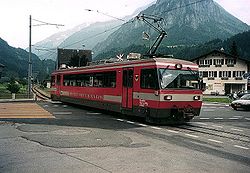- Meiringen–Innertkirchen Bahn
-
Meiringen-Innertkirchen Bahn 
MIB Be 4/4 8 in InnertkirchenTechnical Line length 4.99 km (3.1 mi) Track gauge 1,000 mm (3 ft 3 3⁄8 in) Electrification 1200 V, DC Overhead Maximum incline 2 % Rack system None Meiringen-Innertkirchen-Bahn Legend


Zentralbahn from Luzern and Interlaken 


0.00 Meiringen 


unelectrified connection track 


0.16 Meiringen MIB 


0.65 Alpbach 


1.37 Aareschlucht West 





Kirchetunnel 1502 m 


3.38 Aareschlucht Ost 





4.15 Unterwasser 


Chiesten 63 m 


4.44 Innertkirchen Post MIB 


4.99 Innertkirchen MIB The Meiringen–Innertkirchen Bahn (MIB) is a narrow gauge railway in Switzerland with a rail gauge of 1,000 mm (3 ft 3 3⁄8 in). It covers a distance of 5 kilometres (3.1 mi) from Meiringen to Innertkirchen.
Contents
History
The line was originally built as a construction railway to support the building of hydroelectric dams in the Oberhasli and the Grimsel Pass. A company, Kraftwerke Oberhasli (KWO) was founded in 1923 to build and operate the railway; the line opened in 1926. Several Mallet-type steam locomotives were acquired from the Rhätische Bahn to operate the line. As well as construction traffic, the line also operated a limited passenger service for workers and their families. In 1931 a battery railcar was purchased, and a second in 1939.
In 1946 the line received a licence to operate as a public passenger-carrying railway, and to this end the Mieringen-Innertkirchen Bahn company was founded to operate the line as a subsidiary of the owners, KWO.
When the license came up for renewal in 1976, it was decided to upgrade the line drastically. The heavy, four-wheel battery railcars were harsh on the track and trackbed, and were at the end of their economic life. The line was electrified and electric streetcar-type railcars were purchased. Currently three railcars are used to provide the service. Up to 17 out-and-back services are provided daily. Freight traffic is run as demand warrants, largely as spare parts for the power stations which arrive from the Brünigbahn.
Route
The line begins in Meiringen, where it is connected to the Zentralbahn, but the two lines are incompatible electrically and no through services are operated, although the technology to allow electric locomotives or EMU's under different voltages and frequencies and/or under AC or DC has existed for some time now, see Multi-system (rail).
After 1.4 kilometres (0.87 mi) the Aareschlucht is reached at the station of Aareschlucht West. After this the line passes through the 1,502-metre (4,928 ft) long Kirchetunnel.
The line ends in Innertkirchen, where the workshops are also found.
Rolling stock
- Ba 2/2 3 (1931) - taken out of service in 1979. Battery railcar with 12 seats. Sold to the German Railway Society at Bruchhausen-Vilsen where it is numbered T46.
- Bem 4/4 6-7 (1952) - ex Oberrheinische Eisenbahn railcars 63, 65 and 68. Bought and rebuilt in 1977. Railcar 6 was broken up in 1999 and railcar 7 was broken up in around 2001.
- Be 4/4 9 (1961) - ex Regionalverkehr Bern-Solothurn Be 4/4 74. Bought in 1997. Plans to restore it as a historic vehicle for RBS failed in 2007 due to the high cost of asbestos removal.
- Tm II 10 (1959) - ex Brünigbahn Tm II 980
- Be 4/4 8 (1996) - new railcar built by Stadler Rail
- BDe 4/4 11 (1953) - ex Chemins de fer du Jura BDe 4/4 604. Bought and rebuilt in 2005.
References
External links
Categories:- Metre gauge railways in Switzerland
- Railway companies of Switzerland
- Railway lines in Switzerland
- Oberhasli
Wikimedia Foundation. 2010.

